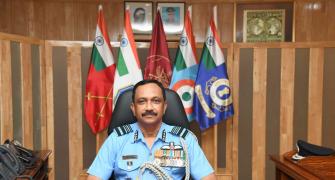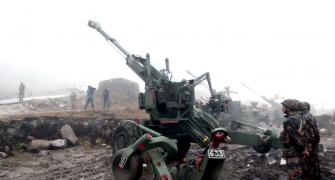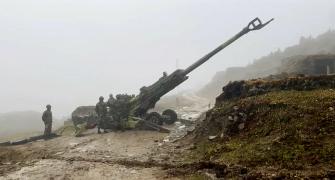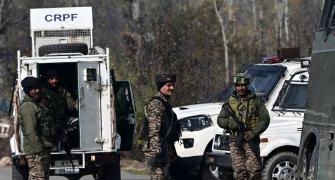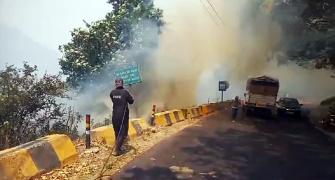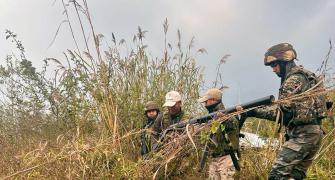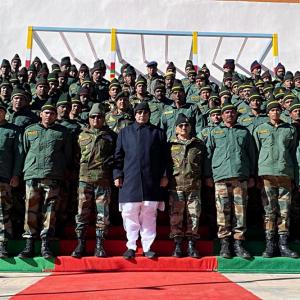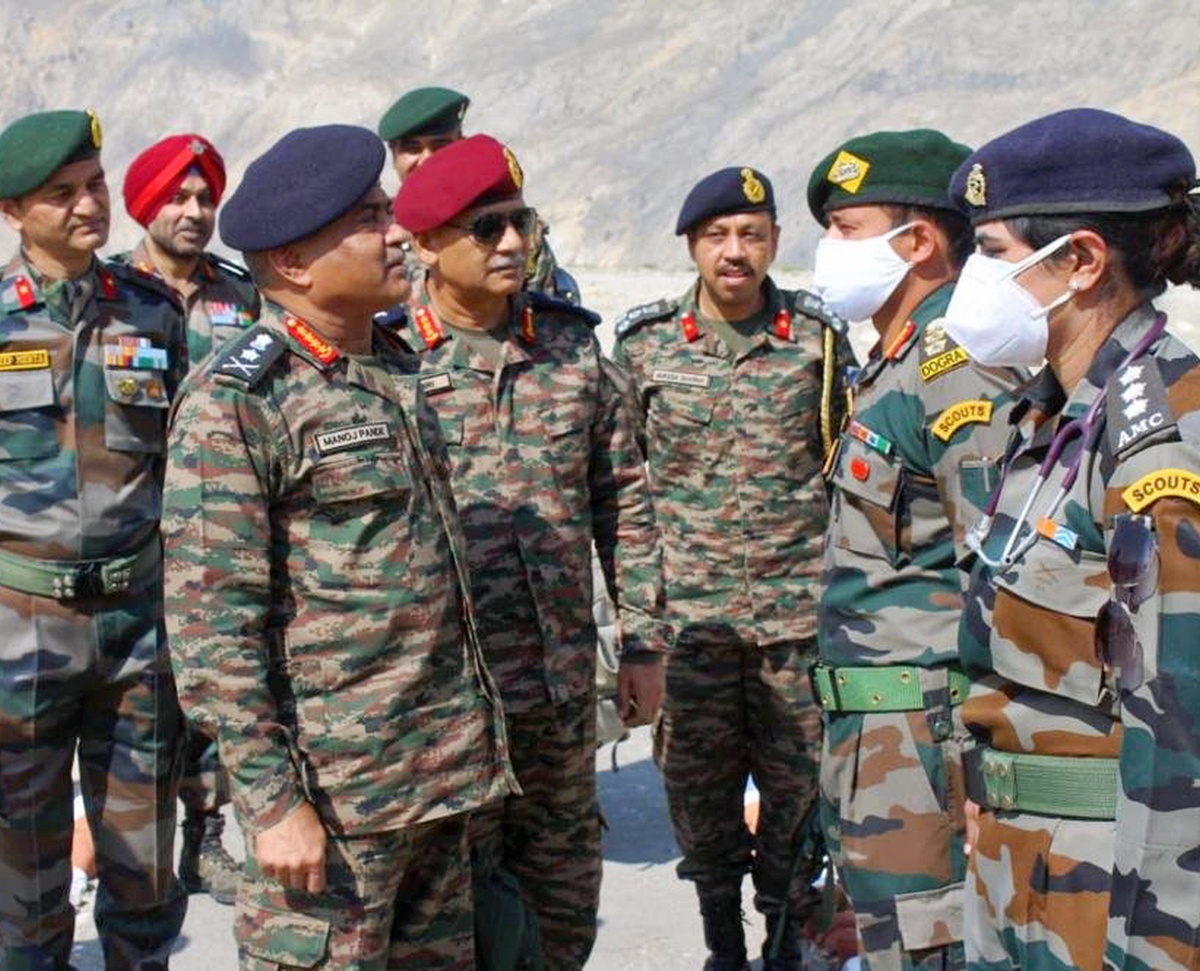'...and then get scaled down somewhat.'
'It will be difficult for any side to occupy meaningful territories, maybe just a bit here and there, and the destruction may vary on either side.'

Air Marshal Gurcharan Singh Bedi (retd) was commissioned as a fighter pilot in June 1984 and has over 3,700 hours of accident free flying on MiG-21 and Mirage 2000 aircraft.
The air marshal is the recipient of the Vayu Sena Medal (Gallantry) for his role in the Kargil War.
A graduate of the Defence Services Staff College, Wellington, and an alumnus of the National Defence College, New Delhi, Air Marshal Bedi has commanded a fighter squadron and a frontline fighter base. He also served as Air Officer Commanding Jammu and Kashmir, Assistant Chief of Air Staff Operations (Offensive) and Senior Air Staff Officer of two operational commands apart from other tenures in his long and illustrious career in the Indian Air Force.
Air Marshal Bedi has had the experience of looking at Chinese fighting capability during his tenures in the north east and Jammu and Kashmir.
With the recent news of the upgradation of Chinese airfields facing India's border, Air Commodore Nitin Sathe (retd) spoke to Air Marshal Bedi for his understanding of this security challenge.
"If a long war is thrust upon us, we should be able to hold on and won't have to seek a ceasefire on unfavourable terms," says the air veteran.
With the current Russia-Ukraine war as a backdrop, what do you have to say of future India-China wars?
Would we be in a position to fight long drawn out conflicts like the war in Ukraine, which is into its 530th day?
We will not have control over the war or when to finish it. If it prolongs like the Russia-Ukraine one, the positive part is that, today, we have the capacity to hold on for this long on our own.
Ukraine has been able to continue like this because of overwhelming outside support which we may not really get.
The future war with China may start at a higher tempo and then get scaled down somewhat.
In my opinion, it will be difficult for any side to occupy meaningful territories, maybe just a bit here and there, and the destruction may vary on either side.
If a long war is thrust upon us, we should be able to hold on and won't have to seek a ceasefire on unfavourable terms.

The PLAAF (People's Liberation Army [Air Force] is modernising/upgrading its forward bases in Tibet.
What do you have to say of the PLAAF capability against the IAF in future conflicts?
Sortie on sortie wouldn't really matter here. The IAF has sufficient sortie generation rate in this sector.
we can launch enough sorties in a day as required for sustaining operations.
Improvement in infrastructure will certainly have a favourable effect for the PLAAF.
We are extremely short on air to air refuellers, and certainly need to increase their strength.
At the same time, this shortfall may not have a large effect on the kind of operations that may unfold in this sector.
The IAF will need to launch greater number of missions, not necessarily for targets in depth.
The refuellers become necessary when you have to travel long distances and are able to refuel when flying over own or friendly territory.
Air to Air refuelling aircraft will be relevant for sustained Air Defence cover.
Air Defence aircraft will need to be on station for long periods to guard our skies and vital areas, but they will necessarily need to remain beyond the Chinese HQ-9 weapon platform ranges.
Also, one may not have PLAAF aircraft intruding deep into our territory since they have adequate stand-off weapons with long ranges on their inventory.
They could, therefore, shoot from long distances and scoot away to their bases.

Can you give us an insight into the battlefield transparency and the ISR (Intelligence, Surveillance and Reconnaissance) capabilities on both sides as on date and in the future too?
How will this govern an India-China war of tomorrow?
They have much greater and better satellite coverage than we have.
This is where we could use our diplomacy to get help from our friends (in getting satellite imagery and analysis).
We are now building up peace time assets through UAVs (Unarmed Aerial Vehicles), which should help.
As of today we lack in this area and this needs serious attention.
What about rocket artillery? It is said that Chinese rockets can reach almost every corner of our country and beyond to take down strategic targets with pin-point accuracy.
What is the number that can be used against us in your opinion and do you think that this remotely carried out battle would be better for the Chinese?
Rocket force needs to be worried about, but I differ on the question of pin-point accuracy of that weapon.
The terminal guidance systems available today are not capable of pin-point delivery of the weapon.
Yes, the new RLGs (Ring Laser Gyros) that the Chinese have are better than the conventional gyros, but still cannot provide pin-point accuracy.
The cruise missiles pose a greater danger. As for the numbers, if they have to continue to cater for the Taiwan contingency, then the number against India, in terms of DF-15 and DF-21 missiles, may be much reduced.
Their total inventory of the same is about 2,000 or so, and they will be at liberty to allocate the resource as they want, depending on their aim. This is only a fair guess.
Unconventional domains like cyber need to be worried about too. I fear we may not be paying much attention towards that.
With the proliferation of Chinese equipment and technology present in just about everything, it poses an imminent danger to us.
They could interfere and degrade performance of their equipment remotely and create hindrances at many levels.
I am of the opinion that, even if they manage to short circuit our equipment or systems to cause us harm, it surely won't provide the notion of victory to them.

How will a future battlefield along the Line of Actual Control be different from what was envisaged over the past few years?
What do you think of the IAF capability to take on the Chinese armies before we get into close contact battle?
What are the vulnerabilities that we are looking at on both sides?
The Chinese army would be largely vulnerable in the area of the Tibetan plateau.
High altitude, cold weather, open grounds without any cover and concealment, and the critical choke points in the valleys of the sector would make them vulnerable to air attacks and the IAF would leverage this aspect.
We are suitably equipped for that, in terms of aircraft, both numbers and technology, weapons and training.

Do you envisage the AH 64 and Chinook amongst helicopters as well as the new strategic lift transport aircraft could be game changers in future conflicts?
They will certainly help, but may not really be game changers. IVTT (Inter Valley Troop Transfer) will be helpful and helicopter firepower in certain situations will certainly be valuable.
One always like to talk about the efficacy and success of using slow moving platforms like the helicopters and UAVs, but please understand that these successes have been in uncontested air space.
Their survivability in an intense battlefield like the one we are talking about is a question mark.

How have both the air forces been training for future wars? Is there a need for some change of tactics/training or equipment for the future?
Have the tactical inputs of the lessons of the Kargil War been implemented?
Are we more capable to fight a war in high altitude mountainous terrain now?
Yes, for most of the questions that you have posed above.
We also have the advantage of training with almost all the advanced air forces of the world.
Our strengths and shortcomings get well documented in these exercises, which can be worked on.
The training status and real capability of both men and machines is generally shrouded in mystery on the other side.
We have formulated tactics based on our experience in Kargil and have practiced the same in all the exercises that we undertake from time to time.
I still feel we should be able to do better here.
Please know that these are purely my thoughts as an informed soldier, and may not be the views of the establishment.
Feature Presentation: Aslam Hunani/Rediff.com

